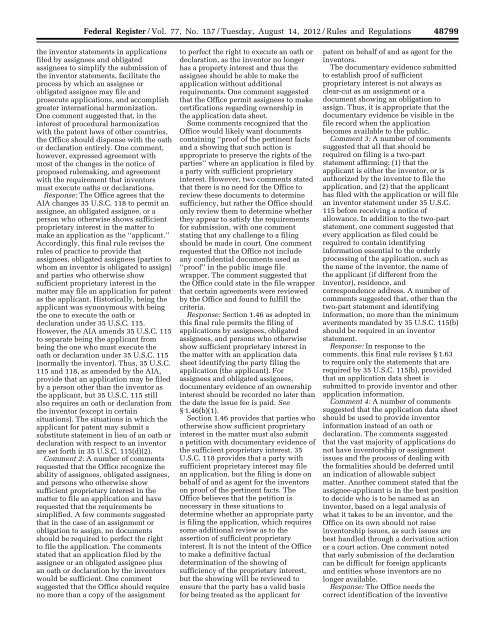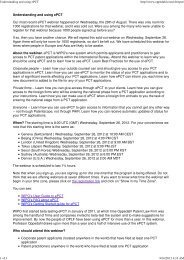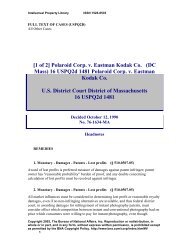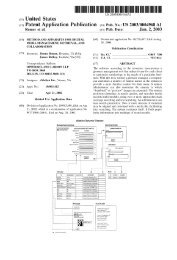48798 Federal Register / Vol. 77, No. 157 / Tuesday, August 14, 2012 / Rules and Regulationssro<strong>be</strong>rts on DSK5SPTVN1PROD with RULESregistration, unless there is anassignment.Section 3.73(b) is amended to provideonly for trademark matters (patentmatters are provided for in § 3.73(c)).Section 3.73(b) provides that in order torequest or take action in a trademarkmatter, the assignee must establish itsownership of the trademark property of§ 3.73(a) to the satisfaction of theDirector, and that the establishment ofownership by the assignee may <strong>be</strong>combined with the paper that requestsor takes the action. Section 3.73(b)further provides that ownership isestablished by submitting to the Officea signed statement identifying theassignee, accompanied by either: (1)documentary evidence of a chain of titlefrom the original owner to the assignee(e.g., copy of an executed assignment),which documents submitted to establishownership may <strong>be</strong> required to <strong>be</strong>recorded pursuant to § 3.11 in theassignment records of the Office as acondition to permitting the assignee totake action in a matter pending <strong>be</strong>forethe Office; or (2) a statement specifyingwhere documentary evidence of a chainof title from the original owner to theassignee is recorded in the assignmentrecords of the Office (e.g., reel and framenum<strong>be</strong>r).Section 3.73(c) provides that in orderto request or take action in a patentmatter, an assignee who is not theoriginal applicant must establish itsownership of the patent property of§ 3.73(a) to the satisfaction of theDirector, and that the establishment ofownership by the assignee may <strong>be</strong>combined with the paper that requestsor takes the action. Section 3.73(c)further provides that ownership isestablished by submitting to the Officea signed statement identifying theassignee, accompanied by either: (1)Documentary evidence of a chain of titlefrom the original owner to the assignee(e.g., copy of an executed assignment),and that the submission of thedocumentary evidence must <strong>be</strong>accompanied by a statement affirmingthat the documentary evidence of thechain of title from the original owner tothe assignee was or concurrently is<strong>be</strong>ing submitted for recordationpursuant to § 3.11; or (2) a statementspecifying where documentary evidenceof a chain of title from the originalowner to the assignee is recorded in theassignment records of the Office (e.g.,reel and frame num<strong>be</strong>r).Section 3.73(c)(2) provides that if thesubmission is by an assignee of less thanthe entire right, title and interest (e.g.,more than one assignee exists), theOffice may refuse to accept thesubmission as an establishment ofownership unless: (1) Each assigneeestablishes the extent (by percentage) ofits ownership interest, so as to accountfor the entire right, title and interest inthe application or patent by all partiesincluding inventors; or (2) each assigneesubmits a statement identifying theparties including inventors whotogether own the entire right, title andinterest and stating that all theidentified parties own the entire right,title and interest.Section 3.73(c)(3) provides that if twoor more purported assignees fileconflicting statements under§ 3.73(c)(1), the Director will determinewhich, if any, purported assignee will<strong>be</strong> permitted to control prosecution ofthe application. This provision sets outthe Office’s practice for treating two ormore conflicting statements under§ 3.73(c), currently discussed in MPEP§ 324, IX.Section 3.73(d) provides that thesubmission establishing ownershipunder § 3.73(b) (for trademark matters)or § 3.73(c) (for patent matters) mustshow that the person signing thesubmission is a person authorized to acton <strong>be</strong>half of the assignee by: (1)Including a statement that the personsigning the submission is authorized toact on <strong>be</strong>half of the assignee; (2) <strong>be</strong>ingsigned by a person having apparentauthority to sign on <strong>be</strong>half of theassignee; or (3) for patent matters only,<strong>be</strong>ing signed by a practitioner of record.37 CFR Part 5Section 5.25: Sections 5.25(a)(3)(iii)and 5.25(b) are amended to deleted the‘‘without deceptive intention’’ clausesfor consistency with the change to 35U.S.C. 184 in section 20 of the AIA.37 CFR Part 10Section 10.23: Section 10.23(c)(11) isremoved and reserved. Section 1.52(c)no longer prohibits changes to theapplication papers after execution of theinventor’s oath or declaration. Thus,§ 10.23 is amended to eliminate theclause concerning knowingly filing orcausing to <strong>be</strong> filed an applicationcontaining any material alteration madein the application papers after thesigning of the accompanying oath ordeclaration without identifying thealteration at the time of filing theapplication papers (except as permittedby § 1.52(c)) as conduct whichconstitutes a violation of § 10.23.37 CFR Part 41Section 41.9: Section 41.9(a) isamended to change the reference to‘‘3.73(b)’’ to ‘‘§§ 3.71 and 3.73.’’Comments and Responses toComments: As discussed previously, theVerDate Mar2010 17:28 Aug 13, 2012 Jkt 226001 PO 00000 Frm 00024 Fmt 4701 Sfmt 4700 E:\FR\FM\14AUR6.SGM 14AUR6Office published a notice on January 6,2012, proposing to change the rules ofpractice to implement the inventor’soath or declaration provisions of section4 of the AIA. See Changes to Implementthe Inventor’s Oath or DeclarationProvisions of the Leahy-Smith AmericaInvents Act, 77 FR at 982–1003. TheOffice received thirty-one writtencomments from intellectual propertyorganizations, academia, industry, lawfirms, individual patent practitioners,and the general public in response tothis notice. The comments and theOffice’s responses to the commentsfollow:A. Assignee Filing.B. Oath/Declaration.1. Time of submission.2. Averments.3. Inventors named.4. Copies in continuing applications.5. Supplemental Oath or Declaration.6. Effective date.7. Miscellaneous.C. Substitute statements.D. Combined declaration and assignment.1. Generally.2. Recordation of assignments.E. Power of attorney.F. PCT.G. Reissue applications.H. Application data sheet (§ 1.76).1. Domestic <strong>be</strong>nefit and foreign priorityclaims.2. Form requirements.I. Miscellaneous rules.1. Mail stop (§ 1.1(e)).2. Signatures (§ 1.4).3. Juristic entity (§ 1.31).4. Correspondence address (§ 1.33).5. Person making declaration (§ 1.64).6. Noncompliant declarations (§ 1.67).7. Statement under § 3.73.8. Lack of deceptive intent.A. Assignee FilingComment 1: A num<strong>be</strong>r of commentsquestioned the Office permittingassignee filing only under the narrowexceptions of death, incapacity, absenceor refusal. A num<strong>be</strong>r of commentssuggested that the rules <strong>be</strong> revised torecognize that ‘‘applicant’’ and‘‘inventor’’ are no longerinterchangeable <strong>be</strong>cause assignees,parties to whom an inventor is obligatedto assign, and parties with a sufficientproprietary interest in the matter, canalso <strong>be</strong> applicants. One comment statedthat by replacing the language in 35U.S.C. 118 (which formerly permittedfiling by other than the inventor only inthe situations where the inventor wasunwilling or unavailable to execute theoath or declaration) with broaderlanguage, Congress has in 35 U.S.C. 118authorized an assignee to file anapplication for a patent as the applicant.A num<strong>be</strong>r of comments requested thatthe rules <strong>be</strong> revised for submission of
Federal Register / Vol. 77, No. 157 / Tuesday, August 14, 2012 / Rules and Regulations48799sro<strong>be</strong>rts on DSK5SPTVN1PROD with RULESthe inventor statements in applicationsfiled by assignees and obligatedassignees to simplify the submission ofthe inventor statements, facilitate theprocess by which an assignee orobligated assignee may file andprosecute applications, and accomplishgreater international harmonization.One comment suggested that, in theinterest of procedural harmonizationwith the patent laws of other countries,the Office should dispense with the oathor declaration entirely. One comment,however, expressed agreement withmost of the changes in the notice ofproposed rulemaking, and agreementwith the requirement that inventorsmust execute oaths or declarations.Response: The Office agrees that theAIA changes 35 U.S.C. 118 to permit anassignee, an obligated assignee, or aperson who otherwise shows sufficientproprietary interest in the matter tomake an application as the ‘‘applicant.’’Accordingly, this final rule revises therules of practice to provide thatassignees, obligated assignees (parties towhom an inventor is obligated to assign)and parties who otherwise showsufficient proprietary interest in thematter may file an application for patentas the applicant. Historically, <strong>be</strong>ing theapplicant was synonymous with <strong>be</strong>ingthe one to execute the oath ordeclaration under 35 U.S.C. 115.However, the AIA amends 35 U.S.C. 115to separate <strong>be</strong>ing the applicant from<strong>be</strong>ing the one who must execute theoath or declaration under 35 U.S.C. 115(normally the inventor). Thus, 35 U.S.C.115 and 118, as amended by the AIA,provide that an application may <strong>be</strong> filedby a person other than the inventor asthe applicant, but 35 U.S.C. 115 stillalso requires an oath or declaration fromthe inventor (except in certainsituations). The situations in which theapplicant for patent may submit asubstitute statement in lieu of an oath ordeclaration with respect to an inventorare set forth in 35 U.S.C. 115(d)(2).Comment 2: A num<strong>be</strong>r of commentsrequested that the Office recognize theability of assignees, obligated assignees,and persons who otherwise showsufficient proprietary interest in thematter to file an application and haverequested that the requirements <strong>be</strong>simplified. A few comments suggestedthat in the case of an assignment orobligation to assign, no documentsshould <strong>be</strong> required to perfect the rightto file the application. The commentsstated that an application filed by theassignee or an obligated assignee plusan oath or declaration by the inventorswould <strong>be</strong> sufficient. One commentsuggested that the Office should requireno more than a copy of the assignmentto perfect the right to execute an oath ordeclaration, as the inventor no longerhas a property interest and thus theassignee should <strong>be</strong> able to make theapplication without additionalrequirements. One comment suggestedthat the Office permit assignees to makecertifications regarding ownership inthe application data sheet.Some comments recognized that theOffice would likely want documentscontaining ‘‘proof of the pertinent factsand a showing that such action isappropriate to preserve the rights of theparties’’ where an application is filed bya party with sufficient proprietaryinterest. However, two comments statedthat there is no need for the Office toreview these documents to determinesufficiency, but rather the Office shouldonly review them to determine whetherthey appear to satisfy the requirementsfor submission, with one commentstating that any challenge to a filingshould <strong>be</strong> made in court. One commentrequested that the Office not includeany confidential documents used as‘‘proof’’ in the public image filewrapper. The comment suggested thatthe Office could state in the file wrapperthat certain agreements were reviewedby the Office and found to fulfill thecriteria.Response: Section 1.46 as adopted inthis final rule permits the filing ofapplications by assignees, obligatedassignees, and persons who otherwiseshow sufficient proprietary interest inthe matter with an application datasheet identifying the party filing theapplication (the applicant). Forassignees and obligated assignees,documentary evidence of an ownershipinterest should <strong>be</strong> recorded no later thanthe date the issue fee is paid. See§ 1.46(b)(1).Section 1.46 provides that parties whootherwise show sufficient proprietaryinterest in the matter must also submita petition with documentary evidence ofthe sufficient proprietary interest. 35U.S.C. 118 provides that a party withsufficient proprietary interest may filean application, but the filing is done on<strong>be</strong>half of and as agent for the inventorson proof of the pertinent facts. TheOffice <strong>be</strong>lieves that the petition isnecessary in these situations todetermine whether an appropriate partyis filing the application, which requiressome additional review as to theassertion of sufficient proprietaryinterest. It is not the intent of the Officeto make a definitive factualdetermination of the showing ofsufficiency of the proprietary interest,but the showing will <strong>be</strong> reviewed toensure that the party has a valid basisfor <strong>be</strong>ing treated as the applicant forVerDate Mar2010 17:28 Aug 13, 2012 Jkt 226001 PO 00000 Frm 00025 Fmt 4701 Sfmt 4700 E:\FR\FM\14AUR6.SGM 14AUR6patent on <strong>be</strong>half of and as agent for theinventors.The documentary evidence submittedto establish proof of sufficientproprietary interest is not always asclear-cut as an assignment or adocument showing an obligation toassign. Thus, it is appropriate that thedocumentary evidence <strong>be</strong> visible in thefile record when the application<strong>be</strong>comes available to the public.Comment 3: A num<strong>be</strong>r of commentssuggested that all that should <strong>be</strong>required on filing is a two-partstatement affirming: (1) that theapplicant is either the inventor, or isauthorized by the inventor to file theapplication, and (2) that the applicanthas filed with the application or will filean inventor statement under 35 U.S.C.115 <strong>be</strong>fore receiving a notice ofallowance. In addition to the two-partstatement, one comment suggested thatevery application as filed could <strong>be</strong>required to contain identifyinginformation essential to the orderlyprocessing of the application, such asthe name of the inventor, the name ofthe applicant (if different from theinventor), residence, andcorrespondence address. A num<strong>be</strong>r ofcomments suggested that, other than thetwo-part statement and identifyinginformation, no more than the minimumaverments mandated by 35 U.S.C. 115(b)should <strong>be</strong> required in an inventorstatement.Response: In response to thecomments, this final rule revises § 1.63to require only the statements that arerequired by 35 U.S.C. 115(b), providedthat an application data sheet issubmitted to provide inventor and otherapplication information.Comment 4: A num<strong>be</strong>r of commentssuggested that the application data sheetshould <strong>be</strong> used to provide inventorinformation instead of an oath ordeclaration. The comments suggestedthat the vast majority of applications donot have inventorship or assignmentissues and the process of dealing withthe formalities should <strong>be</strong> deferred untilan indication of allowable subjectmatter. Another comment stated that theassignee-applicant is in the <strong>be</strong>st positionto decide who is to <strong>be</strong> named as aninventor, based on a legal analysis ofwhat it takes to <strong>be</strong> an inventor, and theOffice on its own should not raiseinventorship issues, as such issues are<strong>be</strong>st handled through a derivation actionor a court action. One comment notedthat early submission of the declarationcan <strong>be</strong> difficult for foreign applicantsand entities whose inventors are nolonger available.Response: The Office needs thecorrect identification of the inventive
- Page 1:
UNIFORM CERTIFICATE OF ATTENDANCE F
- Page 4 and 5:
SPTO explains the America Invents A
- Page 6 and 7:
PTO/SB/01A (01-09)Approved for use
- Page 8 and 9:
PTO/SB/ (06-12)Approved for use thr
- Page 10 and 11:
PTO/ (06-12)Approved for use throug
- Page 12 and 13:
PTO/(06-1Approved for use through 0
- Page 14 and 15:
What will change about the oath ord
- Page 16 and 17:
Action item●●●If you have not
- Page 18 and 19:
But 37 CFR § 1.63 says:A person ma
- Page 20 and 21:
●●●Combined assignment anddec
- Page 22 and 23:
●●●●●●Consequences of i
- Page 24 and 25: How to file the ADSs●●If you pr
- Page 26 and 27: Supplemental ADSAny ADS filed after
- Page 28 and 29: Provisionals●●●Rules are a bi
- Page 30 and 31: Are all assignees applicants?●●
- Page 32 and 33: Substitute Statement●●●This f
- Page 34 and 35: ●●●Docket consequences of the
- Page 36 and 37: New Rule-46 practice67●●●Rule
- Page 38 and 39: Consequences of AIA for PCT filers
- Page 40 and 41: If you are entrusted the US nationa
- Page 42 and 43: ●●●Choosing between a “bypa
- Page 44 and 45: ●●●Getting your name and addr
- Page 46 and 47: Exercises relating to September 16,
- Page 48 and 49: Important AIA webinar September 6
- Page 50 and 51: Exercises relating to September 16,
- Page 52 and 53: 48776 Federal Register / Vol. 77, N
- Page 54 and 55: sroberts on DSK5SPTVN1PROD with RUL
- Page 56 and 57: sroberts on DSK5SPTVN1PROD with RUL
- Page 58 and 59: sroberts on DSK5SPTVN1PROD with RUL
- Page 60 and 61: sroberts on DSK5SPTVN1PROD with RUL
- Page 62 and 63: sroberts on DSK5SPTVN1PROD with RUL
- Page 64 and 65: sroberts on DSK5SPTVN1PROD with RUL
- Page 66 and 67: sroberts on DSK5SPTVN1PROD with RUL
- Page 68 and 69: sroberts on DSK5SPTVN1PROD with RUL
- Page 70 and 71: sroberts on DSK5SPTVN1PROD with RUL
- Page 72 and 73: sroberts on DSK5SPTVN1PROD with RUL
- Page 76 and 77: 48800 Federal Register / Vol. 77, N
- Page 78 and 79: 48802 Federal Register / Vol. 77, N
- Page 80 and 81: 48804 Federal Register / Vol. 77, N
- Page 82 and 83: 48806 Federal Register / Vol. 77, N
- Page 84 and 85: 48808 Federal Register / Vol. 77, N
- Page 86 and 87: 48810 Federal Register / Vol. 77, N
- Page 88 and 89: 48812 Federal Register / Vol. 77, N
- Page 90 and 91: 48814 Federal Register / Vol. 77, N
- Page 92 and 93: 48816 Federal Register / Vol. 77, N
- Page 94 and 95: sroberts on DSK5SPTVN1PROD with RUL
- Page 96 and 97: sroberts on DSK5SPTVN1PROD with RUL
- Page 98 and 99: 48822 Federal Register / Vol. 77, N
- Page 100 and 101: sroberts on DSK5SPTVN1PROD with RUL
- Page 102: 48826 Federal Register / Vol. 77, N





